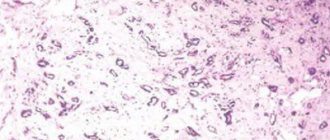Hormone sensitivity
The sensitivity of a tumor to hormones in the analysis is indicated either in points (from 0 to 10) or by number (from 0 to 300) or qualitatively: weakly, moderately, highly sensitive tumor. The presence of hormone sensitivity in a tumor is a good sign: there is another way to influence it (other than chemotherapy). With such a tumor, hormonal therapy helps curb its growth. Survival in the group of patients with a hormone-positive tumor is higher than in patients with a hormone-negative tumor.
In theory, even if tumor metastases (in the bones, lungs and liver) were not detected before the operation, it is impossible to guarantee this 100%. There could be single tumor cells that are simply not visible during ultrasound, radiography, OSG, CT, MRI, PET of these organs. To prevent them from developing, hormone therapy is prescribed.
Read more about the principles of breast cancer treatment HERE (for specialists)
Drug groups
The growth of atypical tissue in the mammary gland directly depends on the level of estrogen in the blood and how strongly it affects the tumor. To reduce these indicators, there are two ways:
- Reduce hormone synthesis in the body.
- Block cell receptors.
Aromatase inhibitors
Aromatase is an enzyme that synthesizes estrogen. It is found in fat and muscle tissue, liver and adrenal cells. Drugs of the inhibitor group have a systemic effect, as they lead to a decrease in the level of estrogen in the blood.
These tablets are indicated for postmenopausal patients. They are not prescribed to women with preserved ovarian function, as they lead to an increase in their production of sex hormones.
- Arimidex. A drug for the adjuvant treatment of early and metastatic breast cancer. The course of treatment is 2-5 years. Side effects: hot flashes, joint pain, vaginal dryness, nausea, loose stools, headaches, increased cholesterol, osteoporosis. Contraindicated during pregnancy and breastfeeding, severe kidney and liver diseases, and taking tamoxifen.
- Femara. Indicated for the treatment of early and late stage cancer, as a component of extended therapy after surgery or a course of tamoxifen. Complications – symptoms of drug-induced menopause: weakness, hot flashes, tachycardia, nausea and vomiting. From the nervous system: headaches, anxiety, depression. During the course, it is necessary to control the number of leukocytes - there is a risk of a decrease in this indicator. Periodic examinations by an ophthalmologist are recommended due to possible damage to the retina. May cause a decrease in the number of white blood cells in the blood. Due to a systemic decrease in estrogen levels, osteoporosis with pain in bones and joints, hair loss, and thrombophlebitis is possible. Contraindicated during pregnancy and breastfeeding.
- Aromasin. The medicine helps reduce the risk of breast cancer coming back. Used when other types of hormone therapy are ineffective. Side effects: nausea, severe weight loss, weakness, insomnia, dizziness, hot flashes, sweating, pain in bones, joints and muscles. Contraindications are the same as for other drugs in this group.
Estrogen receptor blockers
The active substance binds to female hormone receptors on the surface of tumor cells and destroys them. Its use also reduces the number of progesterone receptors. After this, the proliferation of malignant cells stops.
- Fareston. Tablet preparation based on toremifene. Can be used in the presence of metastases after menopause. When prescribed, an additional positive effect is observed: reducing the risk of developing atherosclerosis. Side effects: bleeding from the uterine cavity, weakness, dizziness, increased sweating. It should not be prescribed to women who have been diagnosed with endometrial hyperplasia and polyps, as there is a risk of developing uterine cancer. Not indicated for severe liver diseases, arrhythmias, heart failure, diseases of the parathyroid glands - its action will aggravate the symptoms of the diseases.
- Faslodex. The active ingredient is fulvestrant. Indicated for the treatment of severe breast cancer. Can be used both after completing a course of antiestrogens, and simultaneously with them. The drug is available in the form of a solution for intramuscular injections. Side effects: pain at the injection site, skin rash, nausea, vomiting, weight loss and weakness, hot flashes, increased blood clotting. With long-term use, the likelihood of cystitis and urethritis increases. Contraindicated during pregnancy and lactation, acute nephritis, hepatitis, liver cirrhosis.
Estrogen receptor modulators
This group of drugs is also called antiestrogens. They block receptors on the surface of tumor cells, but do not destroy them, so they have a reversible effect.
Tamoxifen. Also available under the trade name Nolvadex. Taking these tablets is indicated for the treatment of breast cancer at any stage, during menopause. It has an additional therapeutic effect for tumors of the kidneys, ovaries and prostate. The course of treatment lasts from 2 to 4 years. Side effects: in addition to nausea, thrombophlebitis and increased coagulability common to reducing estrogen levels, it damages liver and endometrial cells. With long-term use, fatty liver degeneration and endometrial hyperplasia with bleeding may develop.
Use is contraindicated if the patient has diseases of the veins, liver and endometrium. It is not allowed simultaneously with estrogen-containing drugs, as their effect is neutralized.
Hormone therapy for breast cancer
Foreign colleagues use the Adjuvantonline system, Oncotype DX and MammaPrint tests to prescribe treatment. In our country, the use of these tests is not paid for by insurance companies, and therefore their implementation can only be organized at the expense of patients (the cost is the same as if you paid for it abroad). The point of these tests is that in a number of cases (when chemotherapy and hormone therapy are routinely prescribed according to the standards), based on the results of genetic tests, treatment can be changed by abandoning chemotherapy only in favor of hormone therapy or vice versa. This happens in 1/4 - 1/3 of cases. You can read more about the Oncotype DX and MammaPrint tests HERE.
The results of all these tests allow in 1/3 - 1/4 cases to abandon traditionally planned hormone therapy in favor of chemotherapy and vice versa.
Progesterone receptors
Progestin receptors are designated PR. They are also found on cell membranes. Progesterone interacts with them, stimulating cells to divide.
Cancerous tumors that arise in women before menopause most often do not have such receptors on their membranes (not sensitive to hormone therapy: ER-, PR- or 0 points), while cancer cells in postmenopausal women more often have them (sensitive to hormone therapy , for example: ER+,PR+ or 8 points, 280 or 300). Female sex hormones are synthesized not only by the woman’s ovaries, but also by the adrenal glands, adipose tissue, and sometimes by the tumor itself. Therefore, female sex hormones are present in a woman’s body even after her menstrual function ceases.
What is hormone therapy?
Some cancers use hormones to grow. Hormone therapy in oncology uses drugs to block the effects of hormones. For some types of malignant tumors it is useless. This method is used when the disease is sensitive to this treatment or is hormonally dependent. These types of cancer include:
- breast cancer;
- prostate cancer;
- ovarian tumor;
- uterine cancer;
- malignant kidney tumor.
Hormone therapy changes the levels of hormones in the body. There are three ways to do this:
- Remove the gland that synthesizes hormones.
- Treat the gland with radiation therapy to destroy hormone-producing cells.
- Taking hormones or other drugs that interfere with or stop the production or action of hormones.
Medicines, surgery, or radiation therapy to specific organs affect hormone levels.
Hormone therapy is often combined with other cancer treatments. Sometimes it is used before or after them.
Principles of hormone therapy
Hormone-dependent tumors require hormones to grow and develop. This treatment may slow or stop the disease by:
- blocking hormone synthesis;
- preventing the effect of hormones on cancer cells.
Doctors test tumor samples using tests to determine:
- type of hormonal receptors on the surface of malignant cells;
- number of receptors;
- Will hormone therapy be effective?
The higher the level of the hormonal receptor (positive test), the more sensitive the tumor will be to this method. If there are no or very few receptors (negative test), then the treatment will likely have no effect on the growth of cancer cells and other therapies will have better results.
Hormonal therapy is used both in the early stages of the disease and in the later stages, if the tumor is sensitive to changes in hormone levels. Sometimes the disease initially responds to this treatment but later becomes resistant. In some cases, the tumor begins to grow again and does not respond to further hormonal therapy. In other situations, the disease responds to changing medications. For example, tamoxifen was initially used, then changed to anastrozole (Arimidex) or letrozole (Femara).
doctor
Hormonal therapy for cancer
The mechanism of action of drugs for hormone therapy for breast cancer (anti-estrogen therapy) is as follows:
Some drugs for hormone therapy (Tamoxifen, Toremifene, Fluvestrant) bind to receptors on the membranes of tumor cells, ahead of their similar connection with hormones. Other drugs (Letrozole, Femara, Anastrozole, Exemestane, Goserelin) disrupt the synthesis of female sex hormones in a woman’s body. In any case, without receiving hormonal stimulation, the tumor cell lives to its old age and dies without dividing. Therefore, the prescription of drugs for hormone therapy is long-term, and their regular use is mandatory.
Consequences of hormone treatment
Taking any medication comes with risks. After breast cancer, they are considered acceptable because the therapeutic effect outweighs the possible harmful effects of treatment.
After using hormonal drugs and the onset of menopause, women note a number of negative effects:
- Increased body weight.
- Swelling.
- Changes in hair growth: excess hair growth or alopecia.
- Acne-type rashes.
- Violation of thermoregulation (hot flashes).
- Heavy sweating and unpleasant smell of sweat.
- Nausea.
- Dryness and burning in the vagina.
- Vaginal bleeding.
- Urine leakage.
- Sleep disorders.
- Emotional instability and low mood up to depression.
The latter may not be related to treatment, but may be a consequence of other side effects. If new complaints arise or the condition changes, you need to see a doctor, have your blood tested for hormones, and adjust your treatment.
Removal of ovaries for breast cancer
Removal of the ovaries for breast cancer (adnexectomy) is justified if the cancer progresses (indications are determined by the chemotherapist). In the absence of progression, as an element of hormonal therapy, adnexectomy is offered in countries that are unable to provide their citizens with an appropriate level of modern drug supply: this often happens when it is impossible to provide the patient with Goserelin (Zoladex) for the entire course of treatment.
In cases where a patient with breast cancer has a concomitant gynecological pathology (endometrial hyperplasia, uterine fibroids or ovarian pathology), sometimes, indeed, it is more reasonable to perform gynecological surgery or only adnexectomy (in consultation with the gynecologist).
Hormone therapy drugs
In order to stop or at least slow down the growth of a hormone-dependent tumor, in addition to taking drugs with a chemical composition, it is sometimes necessary to remove the ovaries. They produce maximum estrogen.
Treatment with hormones for breast cancer is carried out in the following areas (there are two):
- Therapy using accounting for the menstrual cycle in treatment.
- Treatment without taking into account MC.
It all depends on the desired result:
- Significant decrease in estrogen in the blood system
- Decreased production of the hormone estrogen.
- Blocking the tumor.
At the end of the examination, a treatment regimen of your choice is prescribed:
- Therapy with tamoxifen is a drug that has antiestrogenic as well as antitumor effects.
- A non-steroid is a blocker drug that suppresses estrogen in the organs. Blocks the development of hypertrophy. Reviews from doctors about this medicine have been very positive, so it has been used for quite a long time.
Indications for use:
- Endometrial oncology.
- Malignant tumor of breast tissue (most often during menopause).
- Stream cancer of female breast tissue.
- For the treatment of gynecomastia in men.
List of effects of hormonal treatment for breast cancer
- Sudden weight gain to incredible levels.
- Early onset of perimenopause and menopause.
- The occurrence of swelling on the body.
- Increased sweating.
- The occurrence of dryness and itching in the genitals.
- Depression and increased irritability in women.
In any case, hormone treatment for breast cancer is the most gentle of all methods of combating the disease. For better results, it is better to combine with other treatment methods.
Anastrozole
Anastrozole is a non-steroidal, essentially an inhibitor of the aromatase enzyme; during postmenopause, andostenedione is converted into estradiol. May also cause a decrease in bone density.
Indications for use:
- Adjuvant therapy for early breast cancer.
Contraindications:
- Kidney failure.
- Osteoporosis, coronary heart disease.
- Cirrhosis of the liver.
- Pregnancy and lactation period.
Faslodex
Blocking and complete destruction of estrogen with Faslodex: solution for intramuscular injection.
Contraindications:
- Pregnancy and breastfeeding.
- Age under 18 years.
- Deviation in liver function.
Side effects:
- Anorexia with long-term use.
- Nausea, diarrhea.
- Skin rash.
- There may be signs of headache.
special instructions
- Women of reproductive age during treatment should be protected from unwanted pregnancy.
- During premenopause, a medical examination is necessary. After an eight-week course, you can stop using contraception.
- If heavy periods occur while taking the drug, you should immediately consult a gynecologist.
- While taking the pills, you should stop driving.
- The drug is not compatible with alcohol intake. Side effects may occur due to ethyl alcohol. The action and effect of the medication is reduced. While taking the clinical drug, it is necessary to take contraceptives. This is required to avoid pregnancy.
When to start hormone therapy
Hormone therapy is not administered simultaneously with chemotherapy. The fact is that both chemotherapy and radiation therapy affect only the dividing tumor cell, while hormone therapy makes it non-dividing. Based on this (in order to achieve maximum effectiveness of chemotherapy and radiation therapy), it is better to start hormone therapy after completing these treatment methods.
Where to buy drugs for hormone therapy, see HERE
No one is going to use hormone therapy to turn a woman into a man. Your beard and mustache will not grow, your voice will not change.
Tamoxifen
The Nobel Prize was awarded for the invention of Tamoxifen. You should not refuse to take it after studying the instructions - this drug is simply the most studied.
When taking Tamoxifen, some patients reported dizziness during the day when taking it in the morning. However, when the appointment time was moved to the evening, the daytime dizziness disappeared.
The next problem that sometimes (but not always) accompanies taking Tamoxifen is endometrial hyperplasia and uterine bleeding. But these bleedings can occur without Tamoxifen! In the end, even 3 curettages for endometrial hyperplasia and bleeding, or even removal of the uterus, but without stopping taking Tamoxifen, will bring much more benefit in reducing the risk of your disease returning.
Unfortunately, over time, the tumor may get used to the hormone therapy prescribed to you and the disease may return. If you have other medications in your arsenal, they will be prescribed to you. If you have already tried everything, only chemotherapy will remain in reserve. Do not stop taking Tamoxifen on your own. Leave this up to your doctor.
Tamoxifen is not advisable in cases of thrombophlebitis. If you have varicose veins in the legs, consider the option of surgery (phlebectomy or sclerotherapy). After all, if you undergo such an operation today, it is not a fact that you will undergo it in a few years (but such a need may arise).
Tamoxifen is contraindicated in glaucoma. Be sure to tell your doctor if you have it.
With concomitant cardiac pathology, the frequency and degree of its aggravation while taking Tamoxifen was lower than when taking aromatase inhibitors.
In patients who synthesize Cyclin D1, Tamoxifen does not “work”.
An analysis for Cyclin D1 can be taken in the laboratory, tel. 8 (812) 439-95-28.
Nutrition during treatment
During a course of hormone therapy, it is important to adhere to a special diet, which also helps reduce the risk of relapse of the disease.
The diet should contain lean meat, various cereals, fresh vegetables and fruits, seafood, eggs, vegetable fats, and seaweed.
It is necessary to exclude fast food, preservatives, soy, alcoholic beverages, coffee, food coloring and additives. Restrictions are placed on sugar, animal fats, pickles and marinades.
It is advisable that garlic or onion be added to each dish. It is also important to monitor your drinking regime. You need to drink plenty of clean water per day.
Aromatase inhibitors
In Her2/neu positive (Her2/neu3+) and hormone positive (ER+ and PR+) tumors, Tamoxifen did not show adequate effectiveness compared to aromatase inhibitors.
Anastrozole sometimes provokes exacerbations of rheumatoid arthritis. Changing it to Femara (Letrozole) eliminates this side effect. Anastrozole and Femara provoke osteoporosis and require parallel administration of calcium and vitamin D supplements (for example, Calcium D3 from Nycomed), as well as annual control osteoscintigraphy.
An analogue of Letrozole is Loreta (2.5 mg/1 time per day), made in Spain, but much cheaper.
Forecasts for breast cancer SEE HERE
Targeted therapy in combination with hormone therapy
We will separately talk about a class of special drugs used in combination with hormone therapy for advanced breast cancer. These are the newest targeted drugs Ribociclib
(Kisqali),
Palbociclib
(Ibrance),
Abemaciclib
(Verzenio).
They are selective inhibitors of cyclin-dependent kinases 4 and 6, ( CDK4/6
), which help slow the progression of breast cancer by inhibiting two proteins. These proteins, when over-activated, can cause accelerated growth and division of tumor cells.
CDK4/6 enhanced specificity may play a role in stopping uncontrolled tumor cell division by inducing cell cycle arrest, thereby suppressing tumor growth. The discovery of this mechanism of antitumor action, which is fundamentally different from hormone or chemotherapy, was awarded the Nobel Prize in Medicine in 2001.
Drugs of this class are called targeted drugs, they are indicated for advanced or metastatic breast cancer that has a positive HR (hormone receptor) status and a negative HER2 (human epidermal growth factor receptor type 2) status.
Ribociclib (Kisqali)
Indicated in combination with letrozole in the first line of HR+ HER2-. Treatment with ribociclib
increased median progression-free survival to 25.3 months compared with 16 months with letrozole monotherapy, and also reduced the risk of disease progression or death by 44% compared with letrozole monotherapy. Ribociclib demonstrated a reduction in tumor burden with an overall response rate of 53%.
Side effects of ribociclib
: As a complication, it can cause a heart disorder known as QT prolongation. This disease can cause an abnormal heartbeat and lead to death. Patients taking ribociclib should be monitored by a cardiologist and should promptly report changes in heartbeat (fast or irregular heartbeat) or if they feel dizzy or lightheaded.
Ribociclib may cause serious liver problems. The following are dangerous: yellowing of the skin or whites of the eyes (jaundice), dark or brown urine (the color of tea), increased fatigue, loss of appetite, pain in the upper right side of the abdomen (stomach area), bleeding more easily than usual, or bruises.
You should avoid eating pomegranates or pomegranate juice, and grapefruits or grapefruit juice while taking ribociclib. Common side effects of ribociclib
, also, it should be noted nausea, asthenia, diarrhea, thinning or loss of hair, vomiting, constipation, headache and back pain.
Palbociclib (Ibrance)
Palbociclib
in combination with aromatase inhibitors in the 1st line provides a median progression-free survival of more than 2 years, which increases the duration of remission while maintaining the quality of life of patients with advanced breast cancer.
In combination with fullestrant, palbociclib is indicated both in subsequent lines of therapy and in the presence of visceral metastases. Ibrance reduces the risk of progression by 2 times, maintaining quality of life.
The most common adverse drug events in patients receiving palbociclib in combination therapy were neutropenia, leukopenia, infections, fatigue, nausea, anemia, stomatitis, thrombocytopenia, diarrhea, alopecia, vomiting, decreased appetite, and rash.
Overall, neutropenia of any severity was observed in 335 patients (78.3%) in the combination therapy group, with grade 3 neutropenia observed in 226 patients (52.8%) and grade 4 neutropenia in 35 patients (8.2%).
The most common serious adverse effect in patients receiving palbociclib with letrozole was diarrhea (2.4%) and in patients receiving palbociclib with fulvestrant was infection (2%). Because palbociclib has bone marrow suppressive properties, it may predispose patients to infections.
Infections of any severity were reported at higher rates in patients receiving palbociclib with letrozole and in patients receiving palbociclib with fulvestrant compared with patients receiving the corresponding comparator. Grade 3 or 4 infections occurred in 2.6% of patients receiving palbociclib in the combination therapy group.
A higher incidence of pulmonary embolism was observed in patients receiving palbociclib with letrozole (5%) compared with patients receiving letrozole alone.
Palbociclib does not cause clinically significant prolongation of the QT interval and does not require ECG monitoring.
Abemaciclib (Verzenio)
Abemaciclib is indicated:
- In combination with first-line endocrine therapy with an aromatase inhibitor;
- In combination with fulvestrant, prescribed as first or second line endocrine therapy;
- As monotherapy in patients with disease progression after endocrine therapy and one or two lines of prior chemotherapy for metastatic disease.
The most common adverse reactions (≥20%) in the abemaciclib group were diarrhea, fatigue, neutropenia, nausea, infection, abdominal pain, anemia, leukopenia, decreased appetite, vomiting and headache, and thrombocytopenia.
The most common side effect of avemaciclib is diarrhea. The incidence of reports of infections in patients receiving the drug in combination with endocrine therapy was higher compared to monotherapy. Cases of pulmonary infection have been reported in patients without concomitant neutropenia. There were also cases of death in <1% of patients.
Venous thromboembolism was observed in 5.3% of patients receiving abemaciclib in combination with fulvestrant or an aromatase inhibitor and in 0.8% of patients receiving placebo in combination with fulvestrant or an aromatase inhibitor. Also, an increase in the level of ALT and AST was noted in patients receiving Verzenio. Depending on the degree of increase in ALT or AST levels, abemaciclib dose adjustment may be necessary.
Thus, the use of targeted drugs in combination with hormone therapy for breast cancer requires careful monitoring of patients
for timely detection of side effects, dosage adjustment and increase the effectiveness of treatment, duration and quality of life in patients with advanced breast cancer.
Why is hormone therapy better than oophorectomy (removal of the ovaries)?
Currently, the term “oophorectomy”
often means “switching off ovarian function,” which can be carried out not only by surgical intervention (removal of the ovaries), but also by medication (the drug goserelin - Zoladex).
Unlike the medicinal method, removal of the ovaries is an irreversible measure.
, while when using hormone therapy, the ovaries can restore their function. Especially when it comes to women under 45 years old.
In government institutions, surgical intervention is used, that is, bilateral removal of the ovaries, as this is more cost-effective. However, oophorectomy provokes a rapid, sharp lack of estrogen, which is fraught with a significant number of side effects:
- Negative effects of oophorectomy include
fatigue, apathy, weight gain, memory problems, mood swings and depression, blood clots, and bone problems (osteoporosis). - Complications of oophorectomy are delayed but pronounced.
Since the lack of estrogen occurs suddenly, the body responds violently, and all of the above complications are pronounced, which significantly worsens the quality of life of a young woman. - Unlike surgical intervention, with hormone therapy there is no sudden change in the body's hormonal status
, so all side effects are minimal.
It is precisely because of the severity of side effects when carrying out surgical methods of hormone therapy that we recommend giving preference to medicinal methods of hormone therapy for breast cancer, which have been successfully used for a long time in our clinic.
They are characterized by minimal side effects and maximum therapeutic effects. To select hormone therapy for breast cancer
sign up for a consultation with an oncologist, and we will prescribe the optimal treatment strategy for you, taking into account all the necessary factors.
Hormone therapy for breast cancer with unremoved tumor
Sometimes hormone therapy is prescribed in the neoadjuvant setting for unresected tumors. Against the background of such treatment, positive dynamics—tumor reduction—should not seduce the patient into refusing surgery. The effect of hormone therapy may not be stable, and today's optimal conditions for surgery may be missed tomorrow: the tumor may adapt and begin to grow while taking the drugs, and worsened concomitant pathology (for example, the heart) will no longer allow the operation to be performed.
Pros of therapy
Thanks to a course of hormonal treatment, it is possible not only to reduce the likelihood of recurrence of cancer, but also to stop the further spread of the tumor to other organs. In addition, the advantage of this type of treatment is that it helps prevent the transition of cancer pathology to a healthy mammary gland.
Also among the positive aspects, experts highlight the possibility of using such therapy before surgery. As a result, the size of the tumor decreases, which allows the use of organ-preserving methods of tumor removal.










